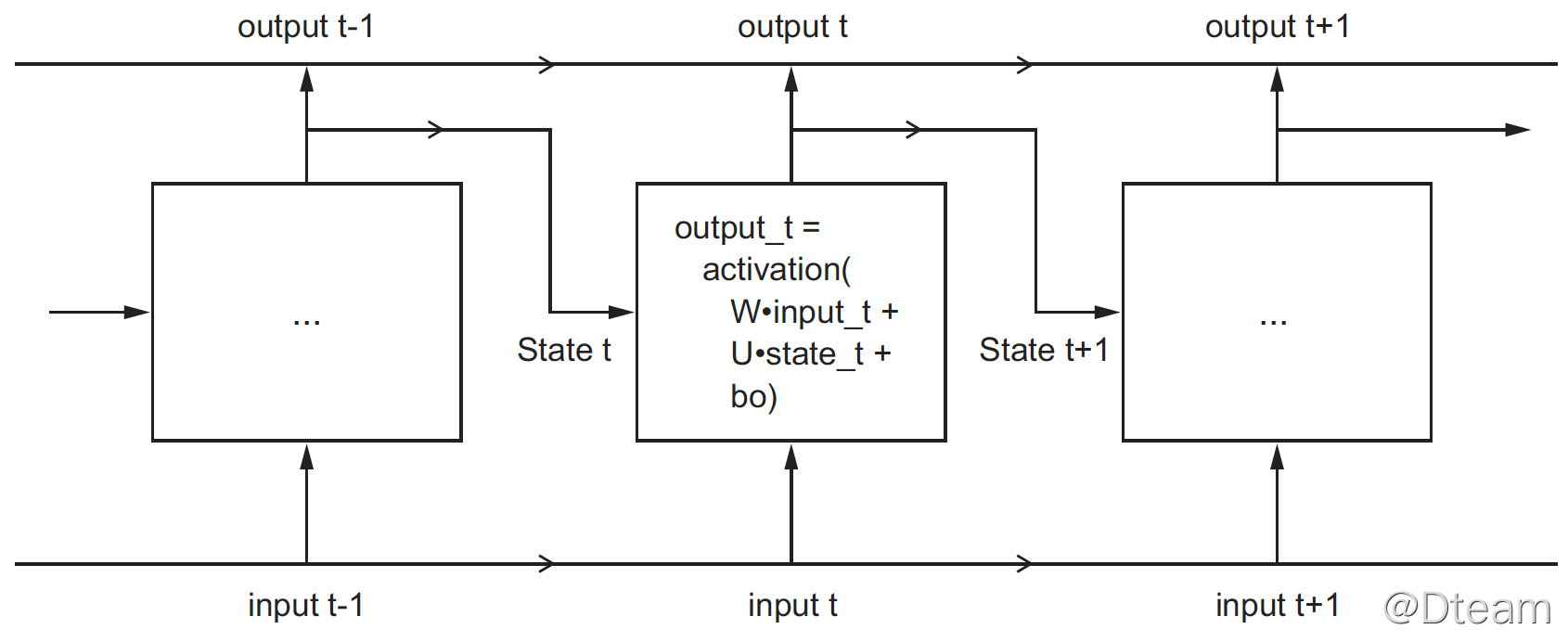

土法炮制:循环网络是如何实现的?
source link: https://blog.dteam.top/posts/2020-02/implement-myrnn-with-tensorflow.html
Go to the source link to view the article. You can view the picture content, updated content and better typesetting reading experience. If the link is broken, please click the button below to view the snapshot at that time.

讲过前馈网络和卷积网络之后,那么就让我们来看看循环网络的实现。
相比前面提到过的网络类型,循环网络存在“记忆”,即它内部会保留过去的状态,并作为下次处理的输入的一部分。因此,在循环网络中,节点的输出如下:
output_t = activation(dot(W, input_t) + dot(U, state_t) + b)
其中,state_t = output_t,上一次的计算结果。将 RNN 概念图展开,得出下图(摘自《Deep.Learning.with.Python》):

本文同样以 imdb 评论为例来进行说明。
使用 Keras 的做法
Keras 中提供了 RNN 的简单实现: SimpleRNN ,先看看如何用它来搭建模型。注意,这里面需要用到 Embedding 层。
import tensorflow as tf
from tensorflow.keras.datasets import imdb
from tensorflow.keras import preprocessing
max_features = 10000
maxlen = 500
# 加载数据
(x_train, y_train), (x_test, y_test) = imdb.load_data(num_words=max_features)
# 预处理数据,将数据分割成相等长度
x_train = preprocessing.sequence.pad_sequences(x_train, maxlen=maxlen)
x_test = preprocessing.sequence.pad_sequences(x_test, maxlen=maxlen)
# 模型定义
model = tf.keras.models.Sequential([
tf.keras.layers.Embedding(max_features, 32, input_length=maxlen),
tf.keras.layers.SimpleRNN(32, return_sequences=True),
tf.keras.layers.SimpleRNN(32),
tf.keras.layers.Dense(1, activation='sigmoid')
])
model.compile(optimizer='rmsprop',
loss='binary_crossentropy',
metrics=['accuracy'])
# 训练
model.fit(x_train, y_train, epochs=10, batch_size=128, validation_split=0.2)
# 预测
print(y_train[:3])
print(model.predict_classes(x_test[:3]).flatten())
对于 SimpleRNN,其输出可以有两种格式,由 return_sequences 控制:
- = True,返回 (batch_size, time_steps, output_features),即每一次的输出结果都会保存,当 SimpleRNN 后跟 SimpleRNN 时使用。
- = False,返回 (batch_size, output_features),即最后一次的输出,当 SimpleRNN 为最后一个 RNN 层时使用。
使用 TF 实现自定义结构
相比起 TF 的正统实现(layer + cell),本文做了相当的简化:只构建 SimpleRNN 层,主要的代码参考了《Deep.Learning.with.Python》。
同样,为了保证每篇的独立性,所有对象的代码都贴出来了,如果不想看之前重复的代码可以直接去看 MySimpleRNN
MyDense
class MyDense(Layer):
def __init__(self, units=32):
super(MyDense, self).__init__()
self.units = units
def build(self, input_shape):
self.w = self.add_weight(shape=(input_shape[-1], self.units),
initializer='random_normal', trainable=True)
self.b = self.add_weight(shape=(self.units,),
initializer='random_normal', trainable=True)
def call(self, inputs):
return tf.nn.sigmoid(tf.matmul(inputs, self.w) + self.b)
MyEmbedding
class MyEmbedding(Layer):
def __init__(self, input_unit, output_unit):
super(MyEmbedding, self).__init__()
self.input_unit = input_unit
self.output_unit = output_unit
def build(self, input_shape):
self.embedding = self.add_weight(shape=(self.input_unit, self.output_unit),
initializer='random_normal', trainable=True)
def call(self, inputs):
return tf.nn.embedding_lookup(self.embedding, inputs)
MySimpleRNN
自定义 SimpleRNN 层,注意:
- 继承 Layer 的规范,实现 build 和 call 。
- build 负责初始化状态矩阵、权重和偏置,来自 Layer 。注意它们的 shape:
- 权重:输入 x 输出
- 状态矩阵:输出 x 输出
- call 负责计算(内建循环,循环次数即时间步骤,来自第二维长度),来自 Layer 。
class MySimpleRNN(Layer):
def __init__(self, unit, return_sequences=False):
super(MySimpleRNN, self).__init__()
self.units = unit
self.return_sequences = return_sequences
def build(self, input_shape):
self.w = self.add_weight(shape=(input_shape[-1], self.units),
initializer='random_normal', trainable=True)
self.b = self.add_weight(shape=(self.units,),
initializer='random_normal', trainable=True)
self.u = self.add_weight(shape=(self.units, self.units),
initializer='random_normal', trainable=True)
def call(self, inputs):
state = tf.zeros((1, self.units))
outputs = []
for step in range(inputs.shape[1]):
output = tf.nn.tanh(tf.matmul(inputs[:, step, :], self.w) + tf.matmul(state, self.u) + self.b)
outputs.append([output])
state = output
# 注意 shape 的变化
return tf.transpose(tf.concat(outputs, 0), (1, 0, 2)) if self.return_sequences else output
MyModel
class MyModel(Layer):
def __init__(self, layers):
super(MyModel, self).__init__()
self.layers = layers
def call(self, inputs):
x = self.layers[0](inputs)
for layer in self.layers[1:-1]:
x = layer(x)
result = self.layers[-1](x)
return result
def train(self, x_train, y_train, epochs = 5):
loss = tf.keras.losses.BinaryCrossentropy()
optimizer = tf.keras.optimizers.RMSprop()
accuracy = tf.keras.metrics.Accuracy()
dataset = tf.data.Dataset.from_tensor_slices((x_train, y_train))
dataset = dataset.shuffle(buffer_size=1024).batch(64)
for epoch in range(epochs):
for step, (x, y) in enumerate(dataset):
with tf.GradientTape() as tape:
# Forward pass.
y_pred = model(x)
# Loss value for this batch.
loss_value = loss(y, y_pred)
# Get gradients of loss wrt the weights.
gradients = tape.gradient(loss_value, model.trainable_weights)
# Update the weights of our linear layer.
optimizer.apply_gradients(zip(gradients, model.trainable_weights))
# Update the running accuracy.
accuracy.update_state(y, tf.cast(y_pred >= 0.5, dtype=tf.int64))
print('Epoch:', epoch, ', Loss from last epoch: %.3f' % loss_value, ', Total running accuracy so far: %.3f' % accuracy.result(), end='\r')
print('\n')
看看效果吧:
# 定义
model = MyModel([
MyEmbedding(max_features, 32),
MySimpleRNN(32, True),
MySimpleRNN(32),
MyDense(1)
])
# 训练
model.train(x_train, y_train, 10)
# 预测
print(y_train[:20])
print(tf.cast(model(x_test[:20]) >= 0.5, dtype=tf.int64).numpy().flatten())
关于代码注意几点:
- MySimpleRNN 中输出的 shape 的变化,参考上面的定义。
- timestep 长度即为 Sequence 大小
- 尽量使用 tf 的操作来进行 shape 变化,否则容易出现“梯度不存在”的错误,参考错误信息如下:
Gradients does not exist for variables …
Recommend
About Joyk
Aggregate valuable and interesting links.
Joyk means Joy of geeK